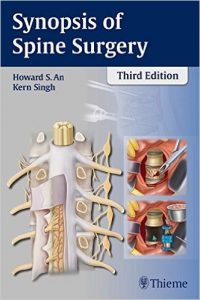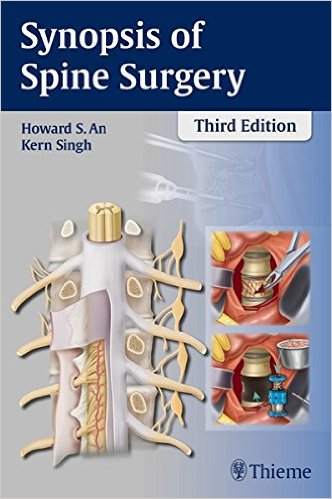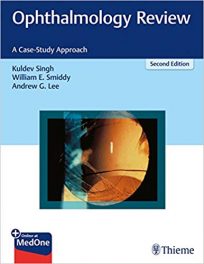 Authors and Editors: Howard S. An, MD; and Kern Singh, MD
Authors and Editors: Howard S. An, MD; and Kern Singh, MD
Publisher: Thieme – 323 pages, with 266 illustrations
Book Review by: Nano Khilnani
This book provides in outline form, important points of knowledge on mainly broad topics in spine surgery, but also on others as shown below, while listing at the end of each chapter, References that you can go to, to get more detailed information.
To give you an overview of what you will find in this handy guide that fits in a pocket, we list below the titles of its chapters:
- Anatomy and Surgical Approaches
- History and Physical Examination
- Radiographic Anatomy
- Spinal Imaging and Diagnostic Tests
- Intraoperative Neuromonitoring
- Biomechanics of the Spine and Spinal Instrumentation
- Physiology of Bone Healing and Fusion
- Bone Grafts, Substitutes, and Biologics
- Evaluation and Management of Spinal Cord Injury
- Cervical Spine Trauma
- Thoracolumbar Spine Fractures
- Spinal Rehabilitation and Disability Evaluation
- Biochemical Aspects of Intervertebral Disk Degeneration
- Degenerative Cervical Spine Disorders
- Degenerative Thoracic Spine Conditions
- Lumbar Disk Disease: Pathogenesis and Treatment Options
- Surgical Management of Lumbar Degenerative Disk Disease
- Lumbar Spinal Stenosis
- Lumbar Spondylolisthesis
- Adult Spinal Deformity
- Pediatric Spinal Deformity
- Pediatric Cervical Spine Disorders
- Spinal Tumors
- Spinal Infections
- Rheumatoid Arthritis
- Seronegative Spondyloarthropathies
Being the third edition, published in 2016, Drs. Howard S. An and Kern Singh write in their brief Preface that this edition “reflects the rapid advances in the field since the first edition – advances that have changed our approach to patient care, particularly involving minimally invasive surgery. In addition, significant advances have been made in bone physiology and biologics.” They add that this book has been written for orthopedic surgeons and neurosurgeons-in-training, practicing spine surgeons and non-operative spine physicians.
Browsing through the chapters, you get a clear view of how the information is presented. It is concise, and the user of the book is able to quickly glance at the lists preceded by bullet points, letters and numbers. Accompanying the lists are full-color, fine-line, detailed, anatomical drawings.
Let us take a look at the very systematic topic outline and other aspects of chapter 1, Anatomy and Surgical Approaches. The topics are simply numbered 1.1, then 1.2, then 1.3, then 1.4. The subtopics under each topic are numbered I, II, III, IV, and so on. Under each subtopic the points of information are identified as A,B,C,D, and so on, which are further categorized under 1,2,3,4, then a., b.,c.,d., and so on. In short, very well organized and if you want to memorize the points for later recall, it should be easy.
So what topics, subtopics, sub-subtopics, etc. will you find in chapter 1? They are the following with the subtopic C. Other anterior approaches detailed below it:
- Basic Anatomy of the Spine
- Neuroanatomy
- Surgical Anatomy
- Surgical Approaches
- Cervical Spine
- Posterior Approaches
- Anterior Approaches
- Other anterior approaches
- Transoral approach to C1-C2
- An anteromedial approach to the upper cervical spine by de Andrade and Macnab
- Anterior retropharyngeal exposure of the upper cervical spine by McAfee
- Anterolateral retropharyngeal approach by Whitesides and Kelley
- Lateral approach to the cervical spine by Verbiest
- Cervicothoracic junction
- Cervical Spine
Under each of the sub-subtopics you will find more detailed information.
This is an excellent, practical handbook with outlined information for thoracic and spine surgeons, and neurosurgeons, and physicians, fellows, and residents in these fields. As a matter of fact, I will suggest that it is a must-have resource.
Editors:
Howard S. An, MD is the Morton International Professor, and Director of the Division of Spine Surgery and Spine Fellowship Program in the Department of Orthopedic Surgery at Rush University Medical Center in Chicago, Illinois.
Kern Singh, MD is Associate Professor and Co-Director of the Minimally-Invasive Spine Institute in the Department of Orthopedic Surgery at Rush University Medical Center in Chicago, Illinois.







